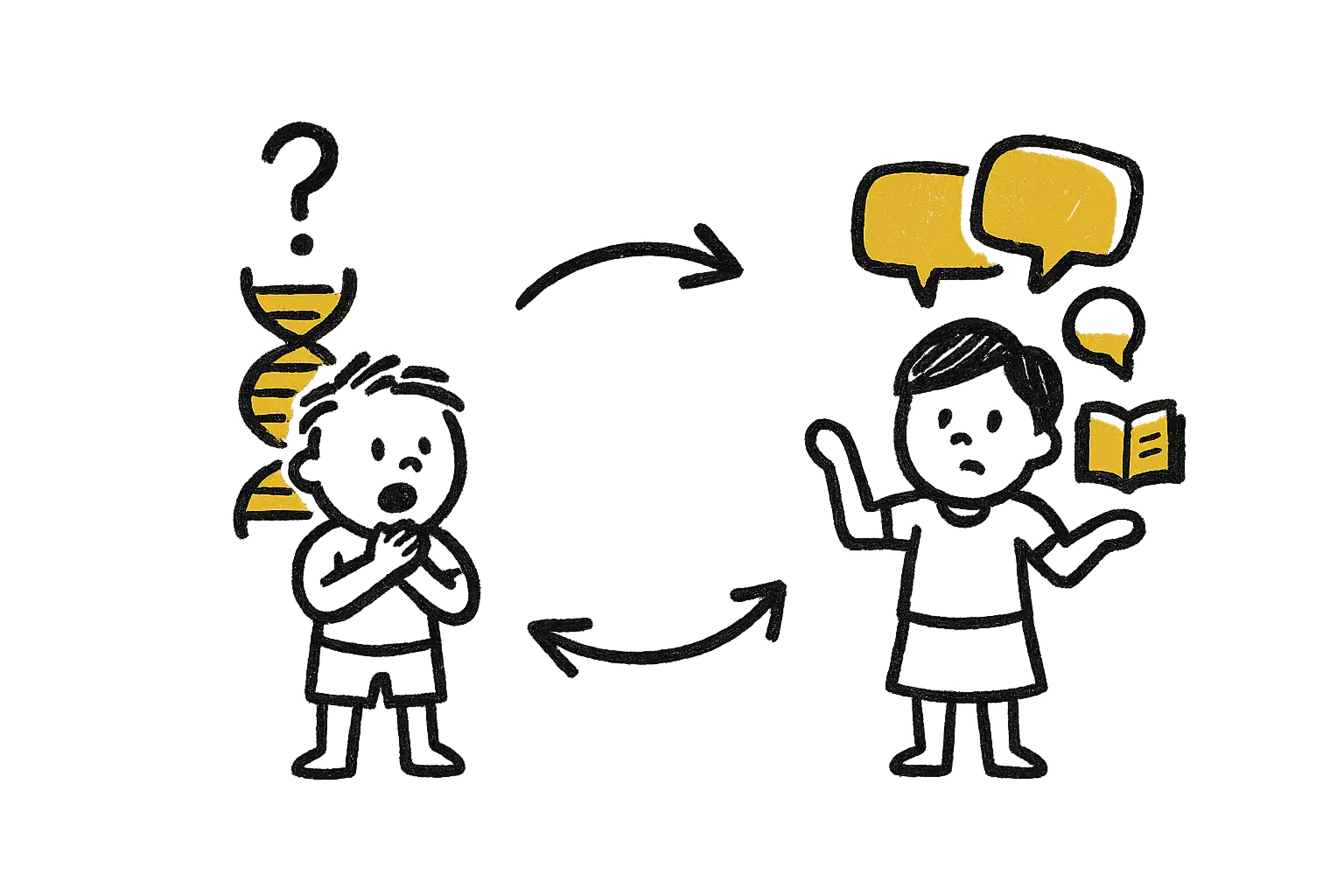Born This Way? Or Made This Way? The Truth About Genetics and Socialization

Genes, Childhood, and the Environments That Shape Us
I’ve always wondered why some kids seem like natural entertainers while others are perfectly happy sorting Legos by color. Or why one friend can charm any room while I’m the one sidestepping small talk at the grocery store.
What I’ve come to realize is that it isn’t just parenting, culture, or the books you read. And it isn’t just DNA either. It’s the collision of the two—your genetic wiring and the social training ground you’re thrown into. In other words: genes are the raw material, environment is the sculptor.
A Quick Primer: Some Terms We’ll Use
Before diving in, let’s pin down a few key ideas:
- Heritability. This is a statistic researchers use to ask: “How much of the differences between people can be explained by genes versus environment?” If heritability for a trait is 50 percent, that means half the variation in a population can be traced to genetics. It does not mean you are 50 percent shaped by your genes.
- Twin studies. Scientists often compare identical twins (who share nearly all their genes) and fraternal twins (who share about half). If identical twins are more alike in a trait than fraternal twins, genes are likely playing a role.
- Dopamine and serotonin. These are brain chemicals that help regulate mood and motivation. Dopamine is often linked to reward and drive, while serotonin helps balance mood and emotional stability.
- Variants or alleles. Think of them as slightly different spellings of the same gene. Everyone has the same basic “word,” but small variations can change how strongly the gene works.
Temperament: The Hand You’re Dealt
From the second a baby comes out screaming—or not screaming—you can already see signs of temperament. Some kids are naturally calm; others are little dynamos.
Developmental psychologist Jerome Kagan showed this vividly. He identified “high-reactive” infants: babies who kicked, flailed, and cried vigorously when faced with something new at four months of age. Some of these children later grew into shy or cautious kids, though many did not. Biology set a bias, not a fate.
Genes lit the spark, but the environment decided how brightly it burned. Reading Kagan’s studies made me think of my daughter—how some of her traits felt baked in, yet a gentle nudge of encouragement could completely shift how she handled a new situation.
Brains, Feelings, and the Social Game
Genes also influence how quickly we learn language, how well we remember, and how we regulate emotions. All of these ripple out into how we connect socially.
- If you’re quick with words, you’ll likely join conversations sooner.
- If you’re prone to anxiety, you may hold back and miss opportunities.
Large twin studies show that personality traits like extraversion—how outgoing or reserved we are—have moderate heritability, around 40 to 50 percent. What this means is that across a population, about half the differences can be traced to genetic variation, while the rest comes from environment and chance.
One clear example: children with a particular version of a dopamine-related gene known as DRD4, especially the “7-repeat” variant, often flourish under warm and supportive parenting but struggle more under harsh or inconsistent care. Same wiring, different outcomes—depending on the environment. This is what researchers call differential susceptibility: some kids are more sensitive to both good and bad environments. In plain language, they’re like orchids—fragile in poor soil, but capable of blooming spectacularly in the right conditions.
The Dance Between Nature and Nurture
Another gene that’s been studied a lot is MAOA (often referred to as the "warrior gene"), which helps regulate brain chemicals like serotonin and dopamine. Early studies suggested that people with certain versions of MAOA who also endured severe childhood adversity were more likely to develop antisocial behavior later in life. Later reviews found the effect modest and inconsistent. Even among “high-risk” combinations, most people did not develop those outcomes.
This is why “warrior gene” headlines are misleading. Genes tilt the field; they don’t decide the game.
Epigenetics: Changing the Script
Epigenetics is about how life experiences can influence whether certain genes are turned “on” or “off.” A helpful way to picture it is like dimmer switches on a circuit board: you inherit the wiring, but your environment controls the brightness.
Some examples from stress research:
- NR3C1, the glucocorticoid receptor gene. This gene helps regulate our sensitivity to cortisol, the main stress hormone. Cortisol mobilizes energy when we’re under pressure. Early nurturing care tends to keep this system balanced, while neglect can make it hyper-reactive.
- FKBP5. This gene fine-tunes how our cells respond to cortisol. Variations in FKBP5, often triggered by childhood trauma, can make stress responses more intense and harder to shut off, leaving a person vulnerable to depression or anxiety.
- BDNF, or brain-derived neurotrophic factor, is a protein that helps brain cells strengthen their connections and even grow new ones. Scientists call these processes synaptic plasticity and neurogenesis—basically, how the brain rewires itself and builds fresh circuits.
When we’re under chronic stress, BDNF can get dialed down through a process called methylation. Methylation adds tiny chemical tags to a gene, acting like a biological mute button: the gene is still there, but it’s harder for the body to “read” and use it. With less BDNF available, the brain can struggle to form and maintain connections, which has been linked to memory problems and emotional difficulties.
Some of these changes can persist for years, and in animals they’ve even been shown to pass to offspring. Human evidence is newer and more tentative, but the message is clear: experience leaves biological fingerprints.
That idea always makes me pause. I sometimes wonder if I carry echoes of my grandparents’ stress responses in my own body.
The Ancient Blueprint in All of Us
Humans didn’t survive because we were the fastest or strongest. We survived because we could bond, cooperate, and learn. One evolutionary clue is that humans have an unusually long childhood compared to other primates. Those extra years are like nature buying us an extended apprenticeship: more time to absorb language, culture, and social rules before venturing into adulthood.
Cultural and Population Differences
Genes may be universal, but their effects play out differently depending on context.
One large cross-national twin study found that heritability for traits like intelligence or self-control was higher in societies with more equality. What this means is that when everyone has access to similar schools, food, and healthcare, genetic differences stand out more. In unequal settings, environment carries more weight.
The DRD4 7-repeat story also illustrates cultural variation. In Western families, the gene makes children more sensitive to both supportive and harsh parenting. But in rural China, the same gene didn’t carry the same risks. Collective caregiving and cultural norms seemed to buffer extremes.
Parenting styles also differ. Dutch research highlights the benefits of autonomy-supportive parenting—encouraging children to make choices. Kenyan ethnographies emphasize early responsibility and kin support. Both interact with children’s biology, but in very different ways.
To me, this is a reminder: genes set the stage, but the play is written in culture.
Busting a Common Myth
Having “anxiety genes” or “shyness genes” doesn’t doom anyone to a disorder. Genetic predispositions set starting points, but actual outcomes emerge from many genes interacting with environment and development.
Think of genes as tilting the playing field, not locking the score.
So What’s the Bottom Line?
Genetics is the raw material. Socialization is the sculptor. Together, they shape us.
If you lean shy, it’s not a curse—it’s a starting point. If you’re a natural talker, that’s a gift, but it still takes shaping. The point is: neither genes nor environment alone decide your fate. It’s the dance between the two.
👉 Practical takeaway
- If you’re naturally introverted, start with smaller groups or one-on-one conversations.
- If you’re prone to anxiety, gradual exposure often works better than a big leap.
- If you’re highly reward-sensitive, surround yourself with supportive people.
The key is working with your temperament, not against it—while still nudging yourself to grow.
Nerd Notes: Methods & Limits
- Heritability is not inevitability. It’s a measure of differences across groups, not a personal destiny. A heritability of 50 percent for extraversion means genes explain half the variation across many people—not that you’re “half extrovert.”
- Gene–environment interactions. Scientists call these G×E effects. They mean some genes matter more in some environments. Many early findings, like the MAOA × maltreatment story, turned out weaker on replication.
- Epigenetics is exciting but early. Many findings are correlational, meaning they show patterns but not always cause and effect. Changes are often small and differ across tissues.
- Kagan’s categories are not predictions. A high-reactive baby is more likely to become cautious, but environment can either amplify or soften that path.
References
- Bakermans-Kranenburg, M. J., & van IJzendoorn, M. H. (2011). Differential susceptibility to rearing environment depending on dopamine-related genes: Evidence and implications. Development and Psychopathology, 23(1), 39–52.
- Bouchard, T. J., & Loehlin, J. C. (2001). Genes, evolution, and personality. Behavior Genetics, 31(3), 243–273.
- Briley, D. A., & Tucker-Drob, E. M. (2014). Genetic and environmental continuity in personality development: A meta-analysis. Psychological Bulletin, 140(5), 1303–1331.
- Byrd, A. L., & Manuck, S. B. (2014). MAOA, childhood maltreatment, and antisocial behavior: Meta-analysis of a gene–environment interaction. Biological Psychiatry, 75(1), 9–17.
- Caspi, A., McClay, J., Moffitt, T. E., Mill, J., Martin, J., Craig, I. W., … & Poulton, R. (2002). Role of genotype in the cycle of violence in maltreated children. Science, 297(5582), 851–854.
- Haberstick, B. C., Lessem, J. M., Hopfer, C. J., Smolen, A., Ehringer, M. A., Timberlake, D., & Hewitt, J. K. (2014). MAOA genotype, childhood maltreatment, and their interaction in the etiology of adult antisocial behaviors. Biological Psychiatry, 75(1), 25–30.
- Kagan, J., Reznick, J. S., & Snidman, S. (1988). Biological bases of childhood shyness. Science, 240(4849), 167–171.
- Klengel, T., Mehta, D., Anacker, C., Rex-Haffner, M., Pruessner, J. C., Pariante, C. M., … & Binder, E. B. (2013). Allele-specific FKBP5 DNA demethylation mediates gene–childhood trauma interactions. Nature Neuroscience, 16(1), 33–41.
- McGowan, P. O., Sasaki, A., D’Alessio, A. C., Dymov, S., Labonté, B., Szyf, M., Turecki, G., & Meaney, M. J. (2009). Epigenetic regulation of the glucocorticoid receptor in human brain associates with childhood abuse. Nature Neuroscience, 12(3), 342–348.
- McLaughlin, K. A., & King, K. (2015). Developmental trajectories of anxiety and depression during adolescence. Journal of Abnormal Child Psychology, 43(2), 311–323.
- Polderman, T. J. C., Benyamin, B., de Leeuw, C. A., Sullivan, P. F., van Bochoven, A., Visscher, P. M., & Posthuma, D. (2015). Meta-analysis of the heritability of human traits based on 50 years of twin studies. Nature Genetics, 47(7), 702–709.
- Roth, T. L., Lubin, F. D., Funk, A. J., & Sweatt, J. D. (2009). Lasting epigenetic influence of early-life adversity on the BDNF gene. Biological Psychiatry, 65(9), 760–769.
- Tucker-Drob, E. M., Briley, D. A., & Harden, K. P. (2013). Genetic and environmental influences on cognition across development and context. Current Directions in Psychological Science, 22(5), 349–355.
- Tucker-Drob, E. M., & Bates, T. C. (2016). Large cross-national differences in gene × socioeconomic status interaction on intelligence. Psychological Science, 27(2), 162–173.
- Turecki, G., & Meaney, M. J. (2016). Effects of the social environment and stress on glucocorticoid receptor gene methylation: A systematic review. Biological Psychiatry, 79(2), 87–96.
- Wertz, J., Caspi, A., Ambler, A., Arseneault, L., Belsky, D. W., Danese, A., … & Moffitt, T. E. (2019). Genetics of nurture: A test of the hypothesis that parents’ genetics predict their observed caregiving. Developmental Psychology, 55(7), 1461–1472.
- Wesseldijk, L. W., Bartels, M., & Boomsma, D. I. (2020). Genetic and environmental contributions to self-control in adolescence: A twin study. Psychological Science, 31(9), 1160–1170.


Member discussion